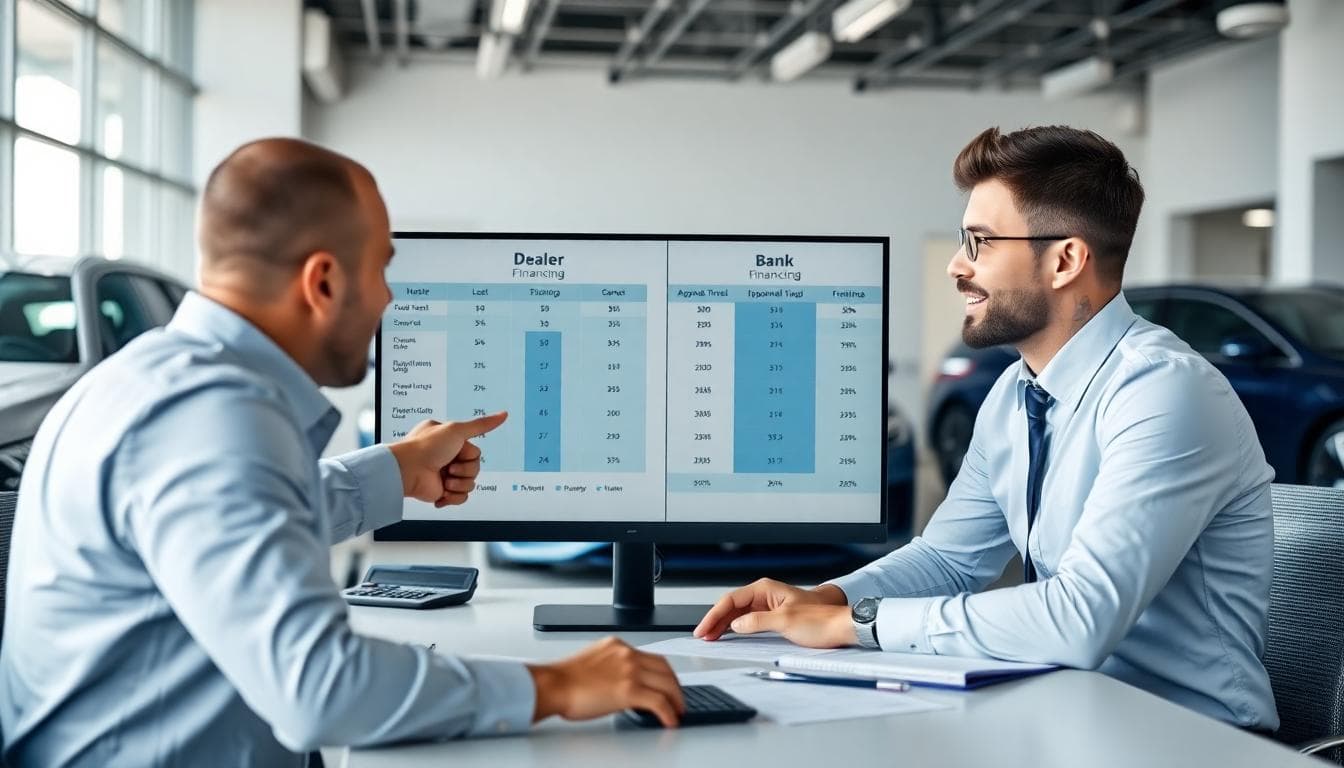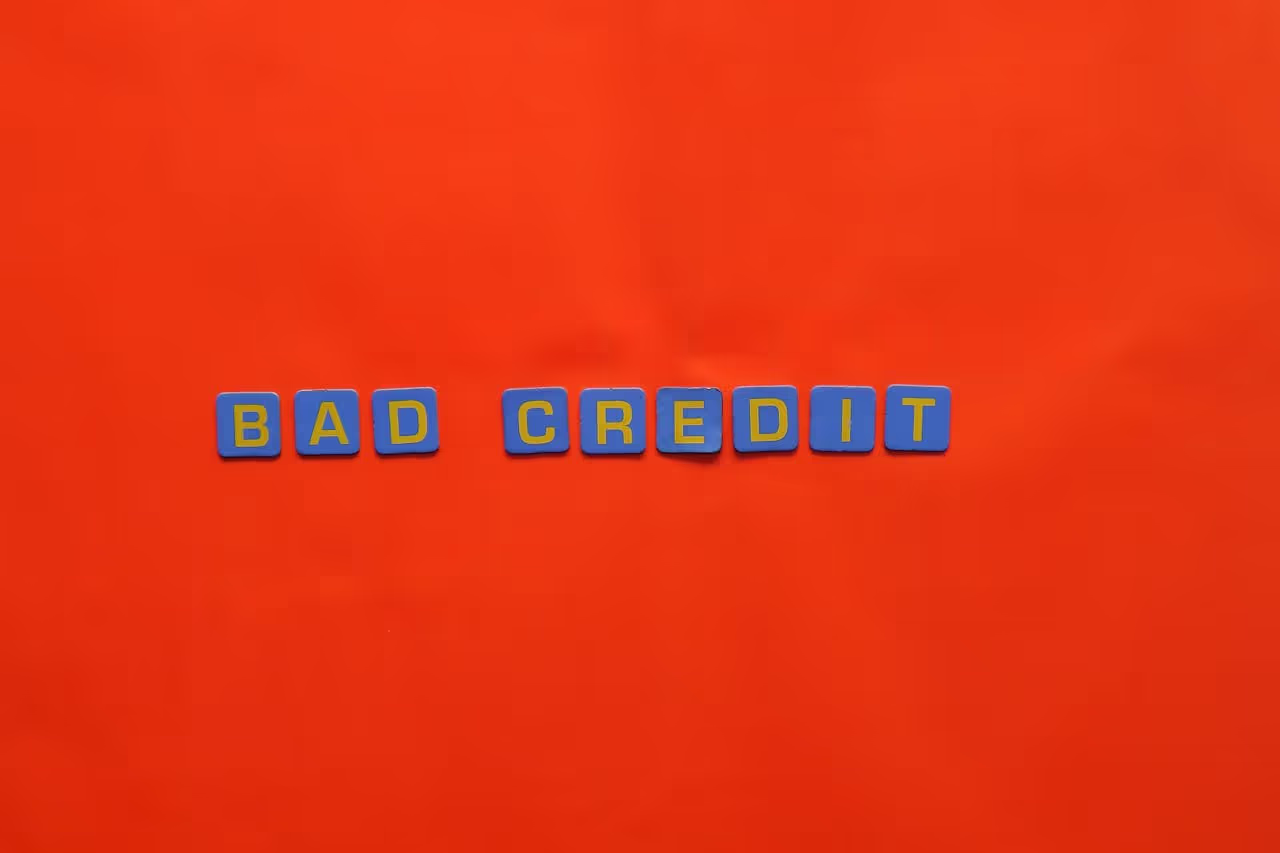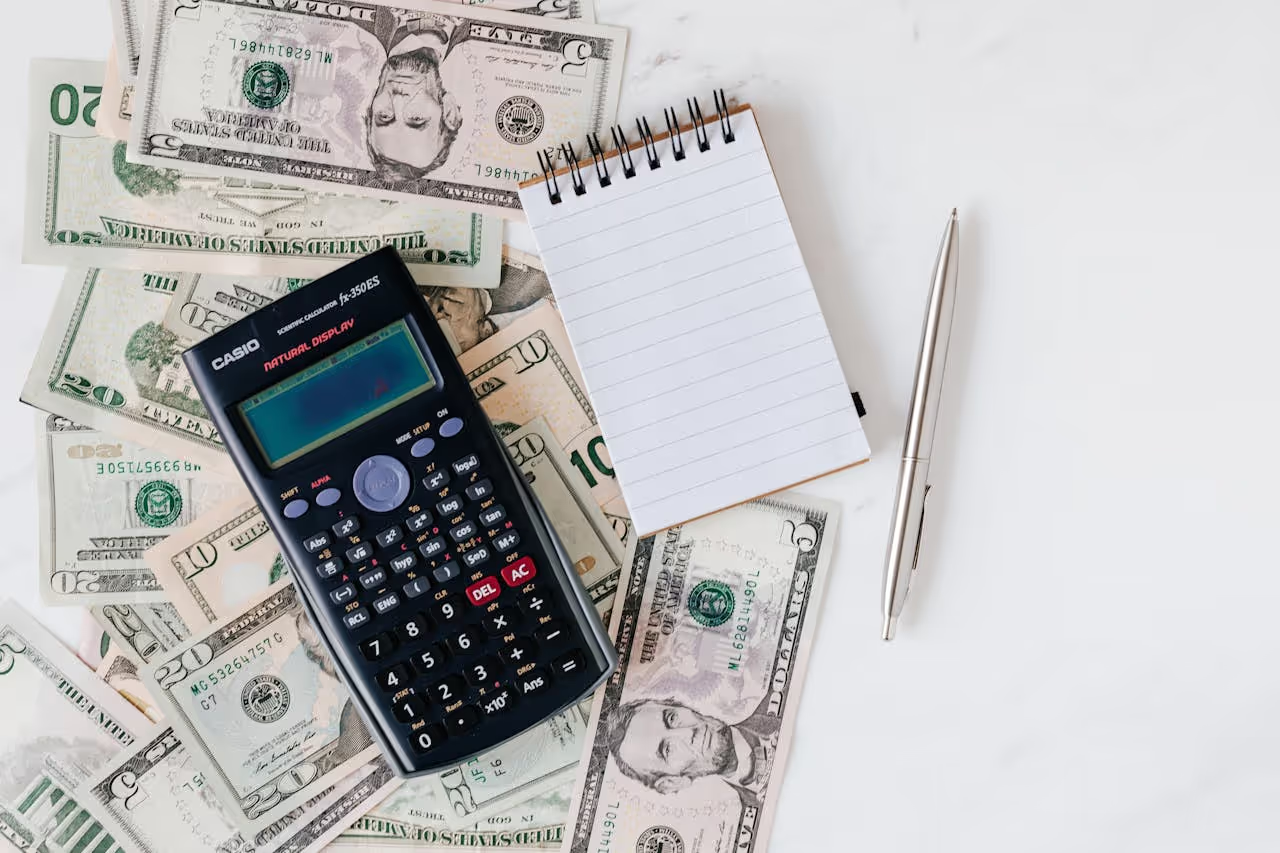Dealership Financing vs Credit Union
Bank Loan vs Dealer
You found the right car, now the finance office slides two offers across the desk. In the Bank vs Dealer Loan debate, dealer financing vs bank financing, which is better? Short answer, it depends on your rate, fees, credit, and how fast you need approval.
In 2025, prices have steadied but stickers remain high, and incentives are back. Every point on your APR matters, so the choice between a bank loan vs dealer, or dealership financing vs direct lender, can save you thousands over the term.
Here is what you will get next: a clear side-by-side comparison table, interest rate differences, approval speed comparison, credit score requirements, and a hidden fees breakdown. You will also see real examples with numbers and a simple decision flowchart so you can pick the best path with confidence.
If you want a quick rule of thumb, banks and credit unions often beat dealer rates for strong credit, but dealers can win with factory-subsidized offers and faster approvals. We will show when to say yes to the dealer, and when to bring your own loan.
What Is Dealer Financing and How Does It Work?
 Photo by Antoni Shkraba Studio
Photo by Antoni Shkraba Studio
Dealer financing is when the dealership arranges your auto loan at the point of sale. You shop, pick a car, and the finance office matches you with a lender, often a bank or the manufacturer’s captive financing arm. You sign one stack of papers, then drive away. The big question in dealer financing vs bank financing is whether the convenience, incentives, or speed offset potential rate and fee trade-offs you might not see right away.
What Dealer Financing Means
Dealer financing is a loan arranged and often originated by the dealer, then usually assigned to a partner lender. The dealer handles paperwork, submits your application to one or more lenders, then presents you with an approval and terms.
Dealer as arranger: The dealer shops your app to multiple lenders, often in minutes.
Lender behind the scenes: A bank or the manufacturer’s finance company funds the loan.
Incentive access: Factory cash, special APRs, or teaser programs may only be available through the dealer channel.
For a clear definition and background, see the overview on Investopedia’s dealer financing guide.
How the Process Works, Step by Step
Here is what happens from handshake to signature:
Application: You share your info once in the finance office by completing the financing application.
Shop to lenders: The dealer runs your app with several lenders to find approvals.
Approval and terms: You get rates, terms, and conditions the lenders return.
Rate setting: The presented rate can include a dealer markup, unless prohibited by program rules.
Add-ons and documents: The finance manager presents optional products and final paperwork.
Funding: You sign, drive off, and the lender funds the contract.
Where Rates Come From
Rates come from two sources:
Standard retail rates: Set by banks that buy dealer contracts. A dealer reserve may apply. Many programs cap or disclose this.
Subvented manufacturer offers: Discounted APRs or cash rebates funded by the automaker’s finance arm through manufacturer deals. These can be strong, sometimes 0 percent for qualified buyers, often tied to dealer incentives. Bankrate explains how dealer-arranged loans and manufacturer financing typically work in practice in its overview on dealer financing and who it is best for.
Quick Snapshot: Dealer Financing vs Bringing Your Own Loan
When you weigh bank loan vs dealer, this high-level view helps.
FactorDealer FinancingBank or Credit Union PreapprovalWho arrangesDealer finance officeYou, before visiting the dealerFunding sourceLenders or captive finance companyYour bankSpeedOften same day at the storeSame day to a few daysIncentivesAccess to factory APR or cashUsually no factory APR incentivesRate riskPossible dealer markup on standard ratesUsually no markup, direct rateAdd-onsOften bundled at signingYou choose separately
Why Buyers Choose Dealer Financing
Dealer financing shines when you value speed, one-stop convenience, or a factory promo that beats the open market.
One application, many offers: The dealer can surface multiple approvals fast.
Access to subvented offers: Manufacturer-sponsored APRs or bonus cash can be hard to match, especially promotional offers.
Same-day delivery: You handle the loan and vehicle pickup in one visit.
When It May Not Be Your Best Bet
There are trade-offs to consider in dealership financing vs credit union or a direct bank loan.
Higher standard rates: Without a factory promo, a credit union often wins on APR.
Add-on pressure: Products like GAP, extended service plans, and VIN etching can raise your out-the-door cost.
Markup risk: Some programs allow a dealer reserve, which increases your offered APR.
Approval Speed and Credit Requirements
Speed is a key win for dealer financing. Many stores return approvals in minutes. The dealer’s network can help buyers with thin credit find an approvable path, although the rate may rise as risk increases.
Prime credit: Approvals are fast at the store and from banks. Compare both.
Near-prime: Dealers may find more options quickly through multiple lenders.
Subprime: Specialized lenders in the dealer’s network can approve where banks may pass, but expect higher rates and more proof of income.
Real Example With Numbers
Here is a simple way to see the impact:
Price: $28,000, tax and fees not included
Dealer standard APR: 7.9 percent for 72 months
Bank APR: 6.1 percent for 72 months
Dealer fees/add-ons: $495 doc fee, $1,195 protection package (optional)
Payment estimate:
- Dealer 7.9 percent: about $489 per month
- Bank 6.1 percent: about $460 per month
Dealer 7.9 percent: about $489 per month
Bank 6.1 percent: about $460 per month
Difference: About $29 per month, or $2,088 over 72 months, before add-ons
If the dealer can offer a factory 1.9 percent for 48 months, the dealer monthly cost may drop below the bank even if the payment term is shorter. That is why you compare dealer financing vs bank financing each time.
Pros and Cons at a Glance
Use this as a quick check before you sign.
Convenience: One-stop shop, faster delivery.
Incentives: Access to special APRs or bonus cash.
Choice: Multiple lenders compete for your deal.
Cost risk: Potential markup and add-ons can raise total cost.
Transparency: More paperwork at once can hide line items if you do not slow down.
How It Differs From a Bank or Credit Union Loan
With a direct bank or credit union loan, you get preapproved before you shop. You bring your rate and limit to the dealership. This sets a pricing guardrail and gives you negotiating power on both the car and the finance terms. In dealership financing vs credit union comparisons, the credit union often wins on standard APR, while the dealer wins on speed and access to factory offers. Your best move is to secure a preapproval, then ask the dealer to beat it.
Practical Tips Before You Say Yes
A few moves protect your budget without slowing you down.
Get preapproved: Know your bank rate before you enter the finance office.
Separate the deals: Negotiate the car price, then the trade, then the financing. This gives you negotiating power.
Ask for the buy rate: Request the lender’s base rate and any markup.
Decline extras you do not want: You can buy many products later if you change your mind.
Check total out-the-door: Focus on total cost, not only monthly payment.
Dealer financing can be the right call when a factory offer is strong or you need rapid approval. A direct loan can be better when you want the lowest standard rate and fewer add-ons. Keep the bank loan vs dealer frame in mind, compare both paths, and choose the one that saves the most over the life of the loan.
What Is Bank Financing and Why Consider It?
 Photo by Erik Mclean
Photo by Erik Mclean
Bank financing means you apply for and secure the auto loan directly through a bank, credit union, or even an online lender, often before you visit the dealership. You get a clear APR, term, and payment that is not marked up by a dealer. In many dealer financing vs bank financing comparisons, banks win on standard rates, while dealers can win with in-house promos and speed.
In 2025, average new-car APRs sit around the mid-6 percent range for well-qualified buyers, with used-car APRs higher. Banks often post the most competitive standard rates, while dealer-arranged loans can include markups. For context on current rate levels, see Bankrate’s snapshot of average auto loan rates in 2025 and the NCUA’s bank vs credit union rates overview for 2025 Q1.
Use this section to see how a bank stacks up on rates, speed, credit requirements, and fees when you compare a bank loan vs dealer or dealership financing.
Interest Rate Differences in Dealer vs Bank Loans
Banks commonly price prime new-car loans near 5 to 7 percent APR in 2025, depending on credit, term, and vehicle. Dealers often present standard approvals at 7 to 9 percent, since many include an interest markup via dealer reserve. Factory-subsidized offers are the exception and can be very low for qualified buyers, but those are not the everyday rate. This direct lender advantage can deliver a lower interest rate without hidden boosts.
Here is a simple side-by-side to frame the gap:
Lender pathTypical 2025 APR for prime buyersNotesBank5 to 7 percentDirect rate, no dealer markupDealer standard approval7 to 9 percent or moreMay include dealer reserve markupDealer factory promo0 to 3.9 percentFor top-tier credit, limited models and terms
For context on averages by credit tier, review Bankrate’s data on rates by credit score.
Example with numbers you can use:
Loan: $30,000, 60 months
Bank at 6.8 percent: about $611 per month, total interest roughly $6,660
Dealer at 7.9 percent: about $629 per month, total interest roughly $7,740
Difference: about $18 per month and $1,080 in interest over 5 years
Add a typical $495 dealer doc fee or add-on, and the gap is roughly $1,575
Another common case:
Bank at 6.0 percent vs dealer at 7.5 percent on $30,000 for 60 months
Savings often land between $2,000 and $2,600 over the term
What moves your interest rate:
Credit score and profile: Biggest driver of APR.
Loan term: Longer terms cost more in interest and sometimes raise APR.
Vehicle type and age: Used cars often price higher than new.
Debt-to-income and down payment: Lower risk can unlock better pricing.
Lender channel: Direct bank vs dealer-arranged with reserve.
Smart negotiation tips:
Arrive with a preapproval from your bank. Ask the dealer to beat it.
Ask for the buy rate. If a dealer shows 7.9 percent, confirm the lender’s base rate and any reserve for a potential rate discount.
Shorten the term if you can. A 60-month term often prices better than 72 or 84.
Increase your down payment to reduce risk and sometimes improve the offer.
Compare same terms. Match APR, months, and fees across offers to make a fair call.
Approval Speed: Dealer Quick Wins vs Bank Thorough Checks
Dealers often deliver same-day approvals, sometimes within an hour, since they submit your application to several partner lenders. That speed can help if you need the car today or you are locking in a weekend deal. Banks can also move quickly, but full approvals may take one to three days due to document checks and funding timelines.
Typical timelines in 2025:
Dealer financing: Decision in minutes to hours, funding same day or next day. Fastest for same-day delivery.
Bank: Preapproval can be minutes to same day, full funding often 1 to 3 business days after final docs. U.S. Bank notes many decisions arrive in about two hours during business hours, which helps close quickly once at the store. See its overview of the auto loan approval process. Broader guidance on final timing is also outlined by SoFi’s guide on when a car loan is finalized.
When speed helps most:
You are replacing a broken car and need transport now.
You want to capture a time-limited incentive or inventory deal.
The car is rare or in short supply and may sell fast.
Trade-offs of speed:
Pros: Less waiting, easier logistics, one-stop closing.
Cons: Rushed choices can hide higher APRs or add-ons. Always pause to compare your bank financing before signing.
Practical move: secure a preapproval first, then let the dealer try to beat it. You get both speed and a guardrail on cost.
Credit Score Requirements: Flexible Dealer Options vs Strict Bank Standards
Banks tend to set higher bars for their best rates. Many want a 650 to 700+ credit score for top-tier pricing. Dealers can place loans with a broader network, including subprime lenders, so buyers with bad credit in the 500s can still get approved, though rates will be much higher.
What to expect in 2025:
Banks: Best terms usually require 650+ credit, with lower APRs for 700+. See Bankrate’s guide to deciding between bank or dealership financing.
Dealers: Approvals are possible with scores around 500 to 620 through specialized lenders, but expect steep APRs and tighter terms. Basic comparisons appear on Bank of America’s overview of bank vs dealer car loans.
Top-tier buyers: May see special captive APRs at the dealer on select models.
Near-prime buyers: Often find more options via the dealer’s lender network, though a credit union may still be competitive.
Quick steps to improve your approval odds:
Check and fix errors on your credit report 30 to 60 days before you apply.
Pay down card balances to lower utilization below 30 percent.
Avoid new credit the month before you shop.
Bring proof of income (recent pay stubs or bank statements) and proof of residence.
Right-size your term and down payment to keep payment-to-income healthy.
If your score sits below 600, a dealer-arranged loan may be the fastest path to approval, but compare total cost and consider a smaller loan or a co-borrower. For a quick benchmark on minimums and tiers, NerdWallet’s guide covers the credit score needed to buy a car.
Hidden Fees Breakdown: Spotting Costs in Both Options
Both paths can include fees. The details differ, so it pays to read everything line by line.
Common dealer costs:
Dealer reserve: A markup above the lender’s buy rate baked into APR.
Doc fee: Often $200 to $900, varies by state.
Add-ons: Extended service plans, GAP, paint protection, window etching, tire and wheel, VIN etching. Some are useful, many are optional.
Ancillary add-ons in payment: Extras rolled into the loan raise total interest paid.
Common bank costs:
Origination fee: Some lenders charge a small fee or none at all.
Title and lien fees: State or lender pass-throughs.
No prepayment penalty: Many banks do not charge one, which helps you refinance or pay off early.
2025 fee examples:
Dealer path: $495 doc fee + $1,195 protection package = $1,690 added to the amount financed. On a 60-month loan, that can add $30 to $40 per month and increase total interest.
Bank path: $0 origination, standard title and state fees only. Another lender may charge a $95 origination fee, which is far less than many dealer add-ons.
How to avoid surprises:
Separate the deal: Negotiate price, then financing, then add-ons.
Decline non-essentials you do not want. You can buy GAP or a service plan later from a third party.
Ask for the buy rate and fee sheet. Confirm reserve, doc fees, and any add-on pricing.
Focus on APR and out-the-door total, not just the monthly payment.
Bottom line for dealer financing vs bank financing, dealership financing vs credit union, bank loan vs dealer: banks often deliver lower standard APRs, cleaner fee structures, and strong transparency. Dealers can move faster and unlock factory promos, which sometimes beat direct rates. Compare both paths on the same terms, put the numbers in writing, and pick the offer that lowers your total cost.
Pros and Cons of Dealer Financing vs Bank Financing
 Image created with AI
Image created with AI
Choosing between dealer financing vs bank financing affects your rate, fees, and how fast you can drive home. Use this section to weigh the trade-offs in bank vs dealer loan options, convenience against total cost, and see when dealership financing is the smarter path.
Dealer Financing: Pros and Cons
Pros
- Speed and convenience: Apply once, get multiple approvals fast.
- Promotional offers: Access to subsidized APRs or bonus cash on select models.
- Broader placement: More options for thin or bruised credit, including buy here pay here for challenging profiles.
Speed and convenience: Apply once, get multiple approvals fast.
Promotional offers: Access to subsidized APRs or bonus cash on select models.
Broader placement: More options for thin or bruised credit, including buy here pay here for challenging profiles.
Cons
- Higher standard interest rates: Dealer reserve can lift your rate.
- Add-on pressure: Extras can inflate the amount financed.
- Less transparency: Fast closings can hide markup and fees.
Higher standard interest rates: Dealer reserve can lift your rate.
Add-on pressure: Extras can inflate the amount financed.
Less transparency: Fast closings can hide markup and fees.
For a simple overview of the trade-offs, see this clear comparison of bank loan vs dealer from a credit union’s guide on financing a car through a dealer or your bank.
Bank Financing: Pros and Cons
Pros
- Lower standard rates: Direct pricing, no dealer markup.
- Fee clarity: Fewer add-ons and cleaner disclosures.
- Negotiating power: A preapproval forces the dealer to compete.
Lower standard rates: Direct pricing, no dealer markup.
Fee clarity: Fewer add-ons and cleaner disclosures.
Negotiating power: A preapproval forces the dealer to compete.
Cons
- Slower funding: Often 1 to 3 business days to finalize.
- Stricter tiers: Top rates usually require stronger credit.
- Separate process: You manage paperwork with your lender.
Slower funding: Often 1 to 3 business days to finalize.
Stricter tiers: Top rates usually require stronger credit.
Separate process: You manage paperwork with your lender.
Quick Side-by-Side
FactorDealer FinancingBank FinancingTypical standard APROften higher due to reserveOften lower, direct rateApproval speedMinutes to hours, same-day deliverySame day to a few daysCredit flexibilityWider, including subprimeStricter for best pricingFees/add-onsMore common at signingGenerally fewer and clearer
Hidden Fees to Watch
Dealer reserve baked into APR
Doc fee that varies by state
Add-ons like GAP, service plans, paint or VIN etch
Bank financing may charge small origination, often none
Real Example With Numbers
Price: $27,000, 60 months
Dealer financing at 7.9 percent: about $546 per month
Bank financing at 6.2 percent: about $523 per month
Difference: about $23 per month, roughly $1,380 in interest over the term
Add a $495 doc fee and a $995 add-on at the dealer, and the gap widens
Fast Decision Flowchart
Get a preapproval from your bank financing.
Ask the dealer to beat your rate with the same term and no extras.
If dealer shows a factory APR that beats your preapproval, run total cost with fees.
If total cost is lower with the dealer, take it. If not, use your bank loan.
For scores under 620, let the dealer place the loan, then plan to refinance later.
Use this as your filter for dealer financing vs bank financing, dealership financing vs bank financing, and any bank loan vs dealer offers placed in front of you.
Side-by-Side Comparison and Real-Life Examples
Use this section to see dealer financing vs bank financing, dealership financing vs credit union, and any bank loan vs dealer offer in a clean head-to-head. Then scan real numbers, so you can spot the better deal in minutes.
 Image created with AI
Image created with AI
Quick Side-by-Side Table
Here is a fast comparison you can use at the desk.
FactorDealer FinancingBank or Credit UnionTypical standard APROften higher due to dealer reserveOften lower, direct rateSpecial APRsFactory promos on select modelsRarely availableApproval speedMinutes to hours, same-day deliverySame day to a few daysCredit flexibilityWider range, including subprimeStricter for best ratesFees and add-onsDoc fees and optional extras commonFewer extras, clearer feesRate transparencyMay include markupNo dealer markupNegotiation powerGood if you have preapprovalStrong, sets a price ceiling
For context on rate markups and why dealer offers often sit higher than direct lenders, see this overview on how to get the best car loan from USA Today.
Interest Rate Differences
Rates move with credit tier, term, and whether the offer is subsidized by the automaker. As a rule, direct bank or credit union loans price lower than standard dealer approvals. Dealer rates can win when a factory special applies.
Standard dealer vs bank: Dealers often quote 1 to 2 points higher due to reserve, while banks and credit unions post direct rates with no dealer markup for a lower interest rate.
Factory specials: Captive financing arms can offer 0 to 3.9 percent for top-tier buyers on select models and terms. These can beat any bank rate.
Anchor your decision with simple math:
Loan: $30,000 for 60 months
Bank at 6.0 percent: about $580 per month, roughly $4,800 in total interest
Dealer at 7.5 percent: about $600 per month, roughly $6,000 in total interest
Difference: about $20 per month and $1,200 over the term
Need a primer on differences between bank and dealer paths? This quick guide lays out the basics from a shopper’s view: Financing with a Bank or Dealership.
Approval Speed Comparison
Speed is a dealer strength. Most stores can submit your application to several lenders at once and get results fast.
Dealer: Decisions in minutes to hours, with same-day delivery common. Helpful if you need the car now or want to lock a unit that may sell.
Bank financing or credit union: Preapprovals can be quick, final funding often takes 1 to 3 business days. Many lenders can still close fast, but timing depends on documents and staffing.
Smart move:
Arrive with a preapproval, then let the dealer try to beat it on the same term and no extras. You get dealer speed with a rate guardrail.
Credit Score Requirements
Credit tiers shape both approval and APR. Dealers can place more complex files. Banks and credit unions reward the strongest credit with the best rates.
Prime buyers, 700+: Best rates at banks and credit unions, and eligible for many factory promos at the dealer.
Near-prime, 620 to 699: Still competitive at credit unions, with dealer access to more lenders if your profile is thin.
Subprime, below 620: Dealer-arranged lenders may approve where banks pass, but rates rise and terms tighten.
If your credit score is in the 500s, consider a smaller loan, higher down payment, or a co-borrower. You can also refinance after 6 to 12 months of on-time payments if your score improves.
Hidden Fees Breakdown
Watch the add-ons and the APR path. The extra items can cost more than a small rate difference.
Dealer reserve: Markup added to the lender’s buy rate. Raises your APR.
Doc fee: Varies by state, often $200 to $900.
Add-ons: GAP, service contracts, tire and wheel, paint protection, VIN etch. Some are useful, many are optional.
Bank or credit union fees: Often no origination fee, standard title and lien costs, fewer extras.
How to keep costs clean:
Ask for the lender’s buy rate and the offered rate, then confirm any markup and push for a rate discount.
Decline extras you do not want. You can buy GAP or a service plan later.
Compare APR, term, and total amount financed across offers.
Real-Life Examples With Numbers
Numbers make the choice clear. Use these examples to frame your own deal.
Example 1, standard offers:
Price: $27,000, tax and fees excluded
Dealer APR: 7.9 percent for 60 months
Credit union APR: 6.2 percent for 60 months
Payment:
- Dealer: about $546 per month
- Credit union: about $523 per month
Dealer: about $546 per month
Credit union: about $523 per month
Gap: about $23 per month, about $1,380 in interest over the term
Add dealer fees: $495 doc fee and a $995 add-on raise the financed amount by $1,490, adding roughly $30 per month
Example 2, factory special at the dealer:
Price: $30,000
Dealer factory APR: 1.9 percent for 48 months
Bank APR: 6.0 percent for 60 months
Payment:
- Dealer 1.9 percent for 48 months: about $651 per month
- Bank 6.0 percent for 60 months: about $580 per month
Dealer 1.9 percent for 48 months: about $651 per month
Bank 6.0 percent for 60 months: about $580 per month
Total interest:
- Dealer: about $1,180
- Bank: about $4,800
Dealer: about $1,180
Bank: about $4,800
Result: Dealer wins on total cost if you can handle the higher payment for the shorter term, comparing the loan term carefully.
 A buyer and finance manager review rate options and payments before signing. Photo by RDNE Stock project
A buyer and finance manager review rate options and payments before signing. Photo by RDNE Stock project
Example 3, subprime approval through dealer network:
Price: $18,000 used car
Dealer APR: 12.9 percent for 60 months
Bank financing: declines due to credit tier
Payment: about $408 per month
Tip: Take the dealer loan, make 6 to 12 on-time payments, then refinance if your score improves. Even a drop to 9.0 percent can save about $1,500 over the remaining term.
Decision Flowchart
Use this quick path to pick the winner on dealer financing vs bank financing, dealership financing vs credit union, and any bank loan vs dealer choice.
Get a preapproval from your bank or credit union. Note APR, term, and max amount.
Ask the dealer to beat your preapproval on the same term and with no add-ons.
If the dealer shows a factory APR, compare total interest and any fees.
If the dealer’s total cost is lower, take it. If not, use your bank or credit union loan.
If you are near-prime, compare payments and total interest with and without add-ons.
If you are subprime, use the dealer to secure approval, then plan to refinance once your credit improves.
Before you sign, confirm:
- The APR and lender name
- The buy rate vs offered rate
- Doc fee and any extras rolled into the loan
- Out-the-door price and total amount financed
The APR and lender name
The buy rate vs offered rate
Doc fee and any extras rolled into the loan
Out-the-door price and total amount financed
Key takeaway: let the numbers choose for you. Put both offers side by side, match term and fees, then pick the lower total cost.
Conclusion
Dealer financing vs bank financing comes down to cost versus convenience. With strong credit, a bank or credit union usually wins on APR and fees, so dealer financing often favors the credit union. If you need speed or a factory promo, the dealer can beat a standard loan vs dealer financing offer, especially in the 2025 new car market where incentives swing deals.
Next step, get preapproved, then ask the dealer to beat your rate on the same term and with no extras. Put offers side by side, include fees, and follow the decision flowchart to pick the lowest total cost. Thanks for reading, share your experience or questions below, and compare fresh quotes before you sign.





